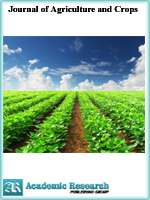Journal of Agriculture and Crops
Online ISSN: 2412-6381
Print ISSN: 2413-886X
Print ISSN: 2413-886X
Quarterly Published (4 Issues Per Year)

Archives
Volume 11 Number 2 October 2025
The Senegalese Grasshopper Oedaleus Senegalensis (Krauss, 1877): Dynamics and Socio-Economic Impact in Senegal
Authors: Mamour Toure ; Amadou Fall ; Amsata Diop, et. al.
Pages: 16-27
DOI: doi.org/10.32861/jac.112.16.27
Abstract
This study, conducted in Senegal between July and October 2021, investigated the population dynamics and economic impact of the Senegalese grasshopper Oedaleus senegalensis, as well as the effectiveness of a community-based pest control strategy. A total of 250 farmers across four regions (Fatick, Kaffrine, Thies, and Saint-Louis) each managed one fertilized and one non-fertilized (control) millet field of one hectare, using the Souna III variety. Fertilized fields received 150 kg each of Nitrogen-Phosphorus-Potassium (NPK) and urea.
Grasshopper densities and development stages were monitored through extensive field sampling and transect observations. Damage was evaluated by estimating leaf and ear attacks, and yield differences between field types were analyzed. In total, 500 hectares were surveyed 1,500 times.
Three grasshopper generations were found in most regions, except in Saint-Louis, where only two were recorded. Densities and movement patterns followed the rainfall gradient, decreasing from Kaffrine to Saint-Louis. Control fields showed higher grasshopper densities (20.25 individuals/are) and attack rates (15%) than fertilized fields (8.5 individuals/are; 2% attack). Correspondingly, fertilized fields yielded 813.95 kg/ha, nearly double the 435.30 kg/ha from control fields.
The results suggest that fertilization, possibly by enhancing millet’s protein content, helps reduce grasshopper infestation and damage.



